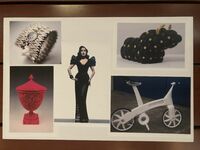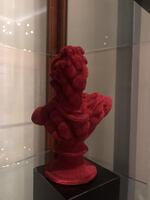Art
Visual artists began to incorporate 3D printing into their work in the early 2000s, when equipment and software became widely available. Today 3D printing is used by craftspeople, designers, and fine artists. Stop-motion animation and fashion are two enterprises that are boldly experimenting and pushing the technology further.
In the composite on the bottom shelf are examples of innovative use of 3D printing by artists, designers, and makers featured in 3D Printing for Artists, Designers and Makers by Stephen Hoskins (London: Bloomsbury, 2018).
Jonathan Monaghan, Department Chair of the Department of Art, is a multi-disciplinary artist whose practice, in his own words, “... explores the transformative effects of technology and consumer culture on perceptions of reality.” His work incorporates influences from historical artworks and science fiction and has both an intellectual and emotional impact. He has exhibited worldwide and his work is in The Phillips Collection (Washington, D.C.), Microsoft Art Collection (Redmond, WA), and Crystal Bridges Museum of American Art (Bentonville, AR).
Monaghan came to 3D printing from designing video games when he was a high school student:
I became familiar with 3D modeling and animation through my childhood interest in video games and video game design. So my first artistic interests were not traditional painters, sculptors, or even video artists, but video game designers and science fiction movies. Playing video games as a child, I was always much more interested in exploring the created environments rather than playing the actual game. This led to me creating custom content and environments for the games I was playing, which led to a BFA in computer graphics and my interest in the contemporary art world.
After working at MakerBot, Monaghan joined the CU faculty in 2013 and requested a consumer-grade printer for the department. 3D modeling is taught in ART386. 3D printing is one of the processes that Monaghan uses to create his computer animations.




